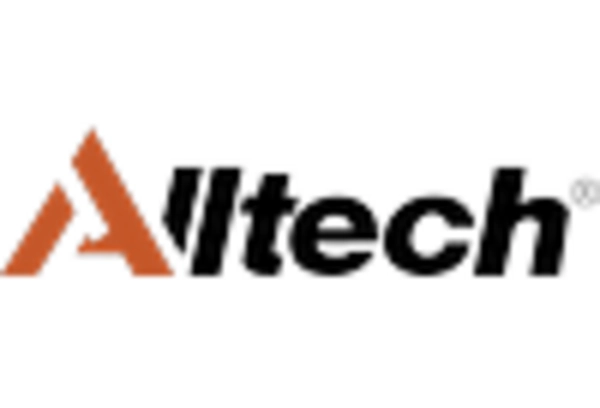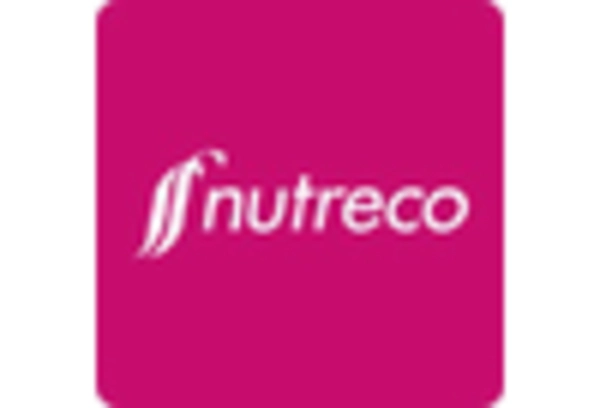Market Analysis
Feed Binders Market (Global, 2026)
Introduction
The Feed Binders Market is poised to play a crucial role in the evolving landscape of animal nutrition and feed formulation, driven by the increasing demand for high-quality livestock products and the need for efficient feed management solutions. As the global population continues to rise, the pressure on the agricultural sector to enhance productivity while ensuring sustainability has never been more pronounced. Feed binders, which serve to improve the physical and nutritional properties of animal feed, are becoming increasingly important in addressing these challenges. The market is characterized by a diverse range of products, including natural and synthetic binders, each offering unique benefits that cater to the specific needs of various livestock species. Additionally, the growing awareness of animal health and welfare, coupled with stringent regulations regarding feed quality, is further propelling the adoption of advanced feed binder solutions. As stakeholders across the supply chain seek to optimize feed efficiency and reduce waste, the Feed Binders Market is expected to witness significant innovations and developments, shaping the future of animal husbandry and feed production.
PESTLE Analysis
- Political
- In 2026, the Feed Binders Market is influenced by various political factors, including government regulations on animal feed safety. The European Union has implemented strict regulations, such as the Feed Hygiene Regulation (EC) No. 183/2005, which mandates that all feed products must meet specific safety standards. This regulation affects approximately 500,000 feed businesses across the EU, ensuring that feed binders used in animal nutrition comply with these safety protocols. Additionally, trade policies and tariffs on agricultural products can impact the availability and pricing of feed binders, particularly in regions reliant on imports.
- Economic
- The economic landscape for the Feed Binders Market in 2026 is shaped by fluctuations in commodity prices and the overall health of the agricultural sector. In 2024, the average price of key feed ingredients, such as corn and soybean meal, was reported at $5.50 and $13.00 per bushel, respectively. These prices directly influence the cost of feed production, including binders, as they are often used in conjunction with these ingredients. Furthermore, the global economic recovery post-pandemic has led to an increase in livestock production, with an estimated 1.5 billion livestock units projected to be in production by 2026, driving demand for feed binders.
- Social
- Social trends in 2026 indicate a growing consumer preference for sustainably sourced animal products, which is influencing the Feed Binders Market. A survey conducted in 2025 revealed that 68% of consumers are willing to pay a premium for products that are certified organic or sustainably produced. This shift in consumer behavior is prompting feed manufacturers to seek out natural and organic feed binders, which are perceived as healthier and more environmentally friendly. Additionally, the increasing awareness of animal welfare standards is pushing producers to adopt better practices, further impacting the types of binders used in feed formulations.
- Technological
- Technological advancements are playing a crucial role in the Feed Binders Market as of 2026. Innovations in biotechnology have led to the development of new, more efficient feed binders that enhance nutrient absorption and improve feed efficiency. For instance, the introduction of enzyme-based binders has shown to increase feed conversion rates by up to 15%, according to recent studies. Furthermore, the integration of digital technologies, such as precision agriculture and data analytics, is enabling feed manufacturers to optimize their formulations and reduce waste, thereby improving overall production efficiency.
- Legal
- Legal factors affecting the Feed Binders Market in 2026 include compliance with international food safety standards and regulations. The Codex Alimentarius, which sets international food standards, has established guidelines that impact the formulation and labeling of feed products. In 2025, over 100 countries adopted these guidelines, which require transparency in ingredient sourcing and safety testing. Additionally, intellectual property laws surrounding the development of proprietary feed binder formulations are becoming increasingly stringent, necessitating that companies invest in legal protections for their innovations.
- Environmental
- Environmental considerations are becoming increasingly important in the Feed Binders Market as of 2026. The global push for sustainability has led to the implementation of stricter environmental regulations regarding waste management and emissions from feed production facilities. In 2024, the Environmental Protection Agency (EPA) reported that agricultural operations contributed to approximately 10% of total greenhouse gas emissions in the U.S. This has prompted feed manufacturers to adopt more sustainable practices, such as utilizing by-products from food processing as feed binders, which can reduce waste and lower the carbon footprint associated with feed production.
Porter's Five Forces
- Threat of New Entrants
- Medium - The Feed Binders Market in 2026 is expected to have moderate barriers to entry. While the capital investment required for production facilities and compliance with regulatory standards can be significant, the growing demand for feed binders may attract new players. Established companies may have brand loyalty and distribution networks that could deter new entrants, but innovative startups with unique formulations could find opportunities.
- Bargaining Power of Suppliers
- Low - Suppliers in the Feed Binders Market are likely to have low bargaining power due to the availability of multiple raw materials and alternative sources. The market is characterized by a wide range of suppliers, which diminishes the influence any single supplier can exert. Additionally, companies can switch suppliers without significant costs, further reducing supplier power.
- Bargaining Power of Buyers
- High - Buyers in the Feed Binders Market will have high bargaining power in 2026, driven by the increasing availability of various products and the price sensitivity of end-users. As more options become available, buyers can negotiate better prices and terms. Additionally, large-scale buyers, such as feed manufacturers, can leverage their purchasing volume to demand discounts and favorable conditions.
- Threat of Substitutes
- Medium - The threat of substitutes in the Feed Binders Market is expected to be medium. While there are alternative binding agents available, the specific properties and functionalities of feed binders make them essential for certain applications. However, advancements in technology may lead to the development of new substitutes that could challenge traditional feed binders, keeping the threat at a moderate level.
- Competitive Rivalry
- High - Competitive rivalry in the Feed Binders Market is anticipated to be high in 2026. The market is likely to see numerous players competing for market share, leading to aggressive pricing strategies and marketing efforts. Companies will need to differentiate their products through innovation, quality, and customer service to maintain a competitive edge, resulting in a highly competitive landscape.
SWOT Analysis
Strengths
- High demand for animal feed products driving the need for effective binders.
- Technological advancements improving the efficiency and effectiveness of feed binders.
- Diverse applications across various livestock sectors enhancing market stability.
Weaknesses
- Dependence on raw material availability which can affect production costs.
- Limited awareness among smaller producers about the benefits of using feed binders.
- Potential regulatory challenges related to ingredient safety and quality.
Opportunities
- Growing trend towards organic and natural feed products creating new market segments.
- Expansion into emerging markets with increasing livestock production.
- Innovations in binder formulations that can enhance nutritional value and feed efficiency.
Threats
- Fluctuations in raw material prices impacting profitability.
- Intense competition from alternative feed additives and binders.
- Changing regulations and standards that may affect market dynamics.
Summary
The Feed Binders Market in 2026 is characterized by strong demand driven by the livestock sector, supported by technological advancements. However, challenges such as raw material dependency and regulatory hurdles persist. Opportunities lie in the growing organic feed trend and market expansion in developing regions, while competition and price fluctuations pose significant threats. Strategic focus on innovation and market education will be crucial for stakeholders to navigate this evolving landscape.

















Leave a Comment